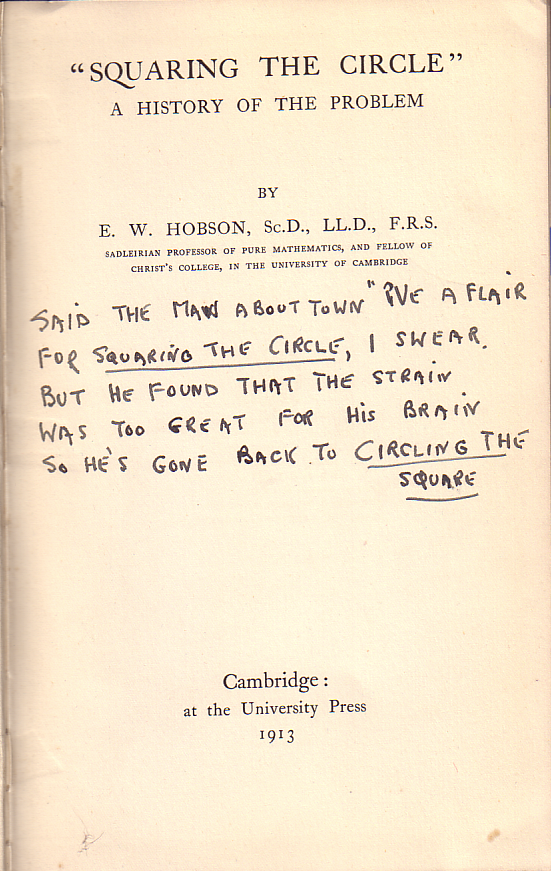E. W. Hobson’s “Squaring the Circle”
December 13, 2007
Roscoe, N.Y.
In 1882 German mathematician Ferdinand Lindemann proved that the ratio of the circumference of a circle to its diameter — the number we know and love as π — is, as was long suspected, not the solution to any algebraic equation. It is, instead, transcendental.
This proof provided an insight into a problem that mathematicians (professional and amateur) had struggled with for over 2,000 years: the problem of squaring the circle. Given a circle, construct a square of equal area using the standard geometric tools of a compass and straightedge. A similar problem is called the rectification of the circle, which requires constructing a straight line equal to the circumference of the circle.
It turns out that constructing geometric objects with a compass and straightedge is equivalent to solving certain algebraic equations. The rectification of the circle requires constructing a line of length 2π; squaring the circle requires constructing a line of length √π. Lengths involving transcendental numbers can't result from solving algebraic equations.
Much of this I learned from a 57-page book entitled Squaring the Circle: A History of the Problem by E. W. Hobson and published by Cambridge University Press in 1913.
English mathematician Ernest William Hobson (1856 – 1933) is famous enough to have a Wikipedia entry that indicates "He was Sadleirian Professor at the University of Cambridge from 1910 to 1931." (After Hobson retired, G. H. Hardy became Sadleirian Professor. Hardy had left Cambridge in 1919 — mostly as a result of the bitter fallout surrounding the dismissal of Bertrand Russell from Cambridge because of his anti-war activities — and had taught at Oxford in the interim.)
I refer to Hobson's Squaring the Circle in Chapter 2 of my forthcoming book The Annotated Turing. Chapter 2 mostly focuses on the work of Georg Cantor but has a background review of the hierarchy of numbers: from natural numbers to integers to rational numbers to algebraic numbers to real numbers. In his paper "On Computable Numbers..." Turing refers to Cantor's two proofs of the non-enumerability of real numbers. Turing uses another E. W. Hobson book, The Theory of Functions of a Real Variable and the Theory of Fourier's Series as source for the first of Cantor's proofs.
Hobson is also mentioned briefly in David Leavitt's recent novel The Indian Clerk. Hobson was one of two Cambridge professors who returned the letters sent to them by Srinivasa Ramanujan without comment. (C. P. Snow's 1967 introduction to Hardy's A Mathematician's Apology alludes to Hobson on pages 33-34 but is discrete enough not to mention his name!)
One of the interesting passages in Squaring the Circle is this:
-
As early as the time of the Greek Mathematicians circle-squaring occupied the attention of non-Mathematicians; in fact the Greeks had a special word to denote this kind of activity, viz. τετραγωνίζειν, which means to occupy oneself with the quadrature. (pg. 3)
It's just like the urban legend of eskimos having hundreds of words for "snow"! Apparently the Ancient Greeks had special words for doing different types of geometry problems!
Unfortunately my ridiculous "education" in the public grade schools of New Jersey disgracefully failed to include either Greek or Latin, but the word τετραγωνίζειν is fairly easy to decode: The first 8 letters correspond directly to the Latin letters for "tetragon," a four-sided figure. The suffix of ‑ίζειν is literally ‑izein but it's actually a rather famous Greek suffix because it has evolved into ‑ize and ‑ise used for making infinitives such as "philosophize" or "philosophise," depending on where you live.
So, τετραγωνίζειν means to "tetragonize." The word is probably easiest to pronounce if you accent the first syllable. I await the day I can actually drop the word in casual conversation.
I probably purchased my copy of Squaring the Circle through AbeBooks.com, which used to be known as the Advanced Book Exchange. It's a great source for used books, and I've purchased literally hundreds of used and out-of-print books through them. (But I still like browsing actual used book stores for those wonderful serendipitous finds.)
Some of the books you purchase through ABE are "damaged" in some way, and you'll generally be warned about the extent of the damage before you order the book. My copy of Squaring the Circle is certainly damaged: It contains frequent underlining (which I can do without) but the copy has some treasures as well. Stuck within the pages of the book is a page ripped from some other book that shows a device used specifically for trisecting an angle. Also stuck in the book is an article (the two sheets of paper held together with a rusty straight pen) from the August 1925 issue of Conquest magazine entitled "How the Circle can be Squared: The Vindication of Papyrus Rhind" by Leonard Joseph.
The book has also been marked in unique ways by its original owner. Written in pencil in the inside front cover of Squaring the Circle is the owner's name (F. B. Allison) and then sideways on the outer edge are the first 66 digits of π and the explanation "written from memory, June 10, '15, FBA"
But that's nothing compared to the inscription on the title page, apparently written with a fountain pen:

Wouldn't it be great if every book came with its own customized hand-written limerick on the title page!